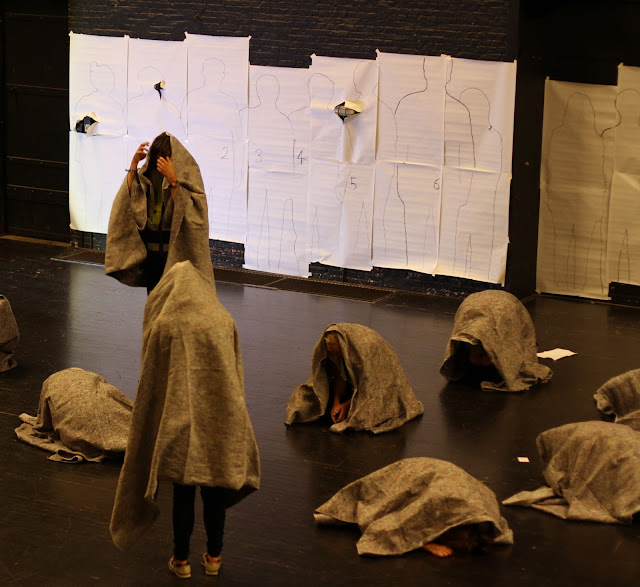 |
| (c) Radhika Iyengar |
Maren Sarenkov is a kindergarten teacher. She is waiting in line with 14 other people outside Florence Gould Hall in New York, to participate in Ant Hampton’s highly anticipated immersive performance, The Extra People. There is excitement in her voice when she exclaims, “I’m looking forward to completely forgetting myself, and just following what someone else tells me to do!”
The Extra People is a part of Art Hampton’s novel Autoteatro series, presented as part of the ninth annual Crossing the Line festival. A site-specific performance, it invites the members of an audience to assume the role of actors. Through a series of instructions, the participants execute given tasks, and the piece develops as they go along. They perform for themselves and for each other. In this work of experiential theater, the boundaries between the audience and the performer disintegrate.
Before you proceed, you are handed a piece of paper with a printed number from 1-15. For the next hour, this number is your sole identifier. Hands on the side, you form a queue with 14 others in ascending order and march inside. Each person is handed a set of headphones and a ‘hi-viz’ vest uniform. The fluorescent vest functions as a unifier; the participants merge into anonymity.
 |
| Photo Credit: Britt Hatzius |
Through headphones, a child’s voice dictates instructions, telling you what you must perform in an enclosed theater setting. The voice seems foreign. It’s monotonous, opaque, and disturbingly fractured. You begin to wonder about its source, and the voice reveals: “There is no ‘I’ behind the voice.” It has been digitally manufactured.
Lucy Simic, a participant and a theater artist, finds the introduction of the synthetic voice fascinating. “I am curious about the choice of using a digital voice,” Simic says. “I believe Ant Hampton’s goal was to create an overall alienating effect, which is quite different from a previous show I saw of his which used recordings of human voices.”
The themes of conformity, alienation and post-apocalyptic worlds pulsate through Hampton’s piece. The first instruction the participants hear is a simple one: You must be seated in the theater within 90 seconds. When you enter, the space is dark, empty and still. Nervous and excited, you can barely see your feet as you scramble to find your seat. The voice continues to instruct with measured cadence. The instructions dictated are peculiar but precise: Act like you are asleep; raise your hand; stand up; and so on. As you perform the tasks assigned with abrupt, unrehearsed gestures, the lights go on.
 |
| Photo credit: Britt Hatzius |
On the stage, the setting seems barren, ominous. Large sheets of white paper patterned with outlines of faceless people function as the backdrop. Across the floor, 15 unidentifiable human beings sit wrapped in ash-grey colored blankets. Suddenly, as though in a trance, they spring up and start twirling. You realize that they are wearing headphones and are following their own set of instructions. Rebecca J. Collier, a professor at Borough of Manhattan Community College, New York, recalls feeling a bit taken aback when she saw the people on stage. “I was surprised to see them, even though I knew they were going to be there,” she says. “I thought it was interesting to see the lines between performer and audience blur. It did feel like [I was] performing for them—when [I would] raise my hand and stand in my seat—and that they were performing for me.”
From shutting your eyelids and raising your hand abruptly in the air, to performing a momentary dervish-like twirl with your arms outstretched, head covered with a blanket—the orders are outlandish and absurd. But in order to be a part of Hampton’s “immersive experience,” you must follow them. You must listen, understand and perform. You must conform.
 |
| Participants go on stage and perform. Photo by Britt Hatzius. |
How does it feel to have the freedom to think and act for yourself temporarily suspended? Sydney Viles, a pre-school teacher says she felt “mechanical and unthinking (sic) during the performance… but, I also enjoyed being relieved of my agency.”
Rebecca J. Collier felt the experience was therapeutic. “For me, it was kind of relaxing to be following instructions,” Collier says. “It took the pressure off worrying if I was doing the right thing.”
David Helbich, a 41-year-old artist from Brussels, says he felt “controlled to the point that I found it hard to concentrate on the experience.”
Perhaps what Hampton is subtly prodding us to think about is our increasing dependency on technology; of relying on it for guiding our actions and making up our minds. The synthetic voice is reminiscent of Apple’s Siri feature. Through The Extra People, Hampton is perhaps imagining a post-apocalyptic world where technology will instruct our movement and we will become mere numbers.
***
This piece was originally published on Columbia University's Arts and Culture Beat.

.jpeg)

